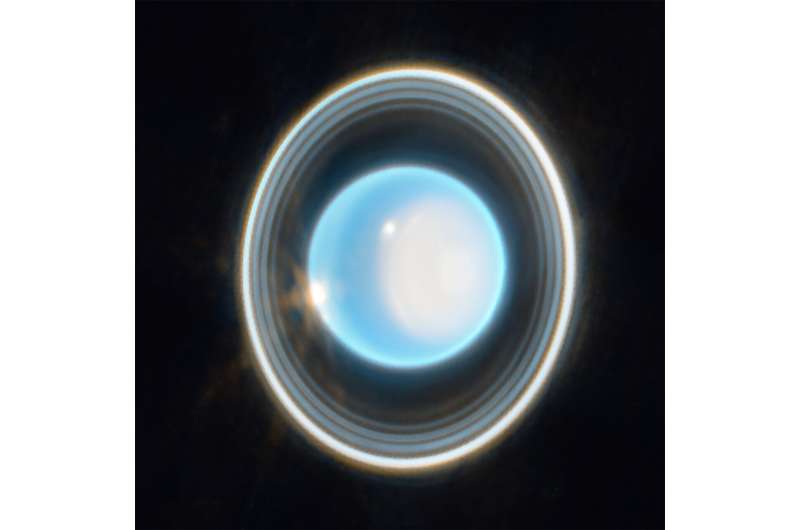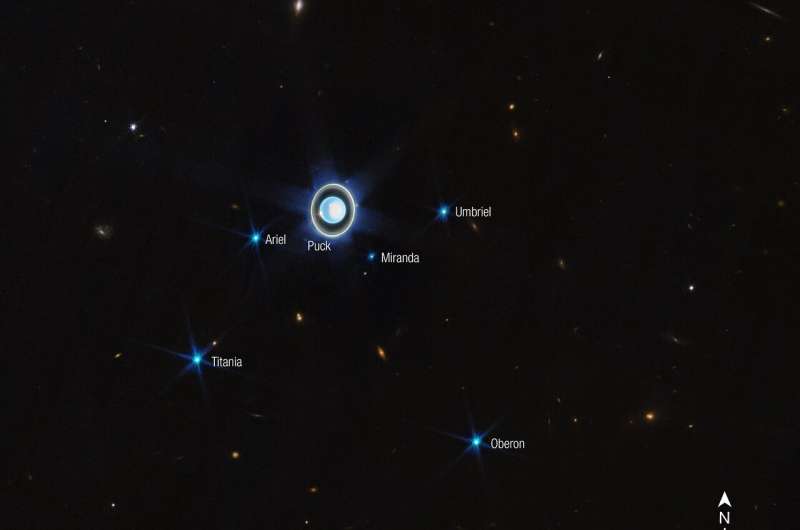This article has been reviewed according to Science X's editorial process and policies. Editors have highlighted the following attributes while ensuring the content's credibility:
fact-checked
trusted source
proofread
Webb adds another ringed world with new image of Uranus

Following in the footsteps of the Neptune image released in 2022, the NASA/ESA/CSA James Webb Space Telescope has taken a stunning image of the solar system's other ice giant, the planet Uranus. The new image features dramatic rings as well as bright features in the planet's atmosphere.
The Webb data demonstrate the observatory's unprecedented sensitivity by revealing the faintest dusty rings, which have only ever been imaged by two other facilities: the Voyager 2 spacecraft as it flew past the planet in 1986, and the Keck Observatory with advanced adaptive optics.
The seventh planet from the sun, Uranus is unique: it rotates on its side, at a nearly 90-degree angle from the plane of its orbit. This causes extreme seasons since the planet's poles experience many years of constant sunlight followed by an equal number of years of complete darkness. (Uranus takes 84 years to orbit the sun.)
Currently, it is late spring at the northern pole, which is visible here; Uranus's northern summer will be in 2028. In contrast, when Voyager 2 visited Uranus it was summer at the south pole. The south pole is now on the 'dark side' of the planet, out of view and facing the darkness of space.
This infrared image from Webb's Near-Infrared Camera (NIRCam) combines data from two filters at 1.4 and 3.0 microns, shown here in blue and orange, respectively. The planet displays a blue hue in the resulting representative-color image.
When Voyager 2 looked at Uranus, its camera saw an almost featureless blue-green ball at visible wavelengths. At infrared wavelengths, and with Webb's greater sensitivity, we see more detail, showing how dynamic the atmosphere of Uranus really is.
On the right side of the planet is an area of brightening at the pole facing the sun, known as a polar cap. This polar cap is unique to Uranus—it seems to appear when the pole enters direct sunlight in the summer and vanishes in the autumn; these Webb data will help scientists understand the currently mysterious mechanism behind this feature. Webb has revealed a surprising aspect of the polar cap: a subtle enhanced brightening at the center of the cap.
The sensitivity of Webb's NIRCam and the longer wavelengths it can see may explain why we can see this enhanced polar feature of Uranus when it has not been seen with other powerful telescopes like the NASA/ESA Hubble Space Telescope and the Keck Observatory.
At the edge of the polar cap lies a bright cloud and a few fainter extended features can be seen just beyond the cap's edge; a second very bright cloud is seen at the planet's left limb. Such clouds are typical for Uranus at infrared wavelengths, and are likely connected to storm activity.

This planet is characterized as an ice giant because of the chemical make-up of its interior. Most of its mass is thought to be a hot, dense fluid of 'icy' materials—water, methane and ammonia—above a small rocky core.
Uranus has 13 known rings and 11 of them are visible in this Webb image. Some of these rings are so bright as seen by Webb that when they are close together, they appear to merge into a larger ring. Nine are classed as the main rings of the planet, and two are the fainter dusty rings (such as the diffuse zeta ring closest to the planet) that weren't discovered until the 1986 flyby by Voyager 2. Scientists expect that future Webb images of Uranus will reveal the two faint outer rings that were discovered with Hubble during the 2007 ring-plane crossing.
Webb also captured many of Uranus's 27 known moons (most of which are too small and faint to be seen here); the six brightest are identified in the wide-view image. This was only a short (12-minute) exposure image of Uranus with just two filters. It is just the tip of the iceberg of what Webb can do when observing this mysterious planet. Additional studies of Uranus are happening now, and more are planned in Webb's first year of science operations.
Provided by NASA





















